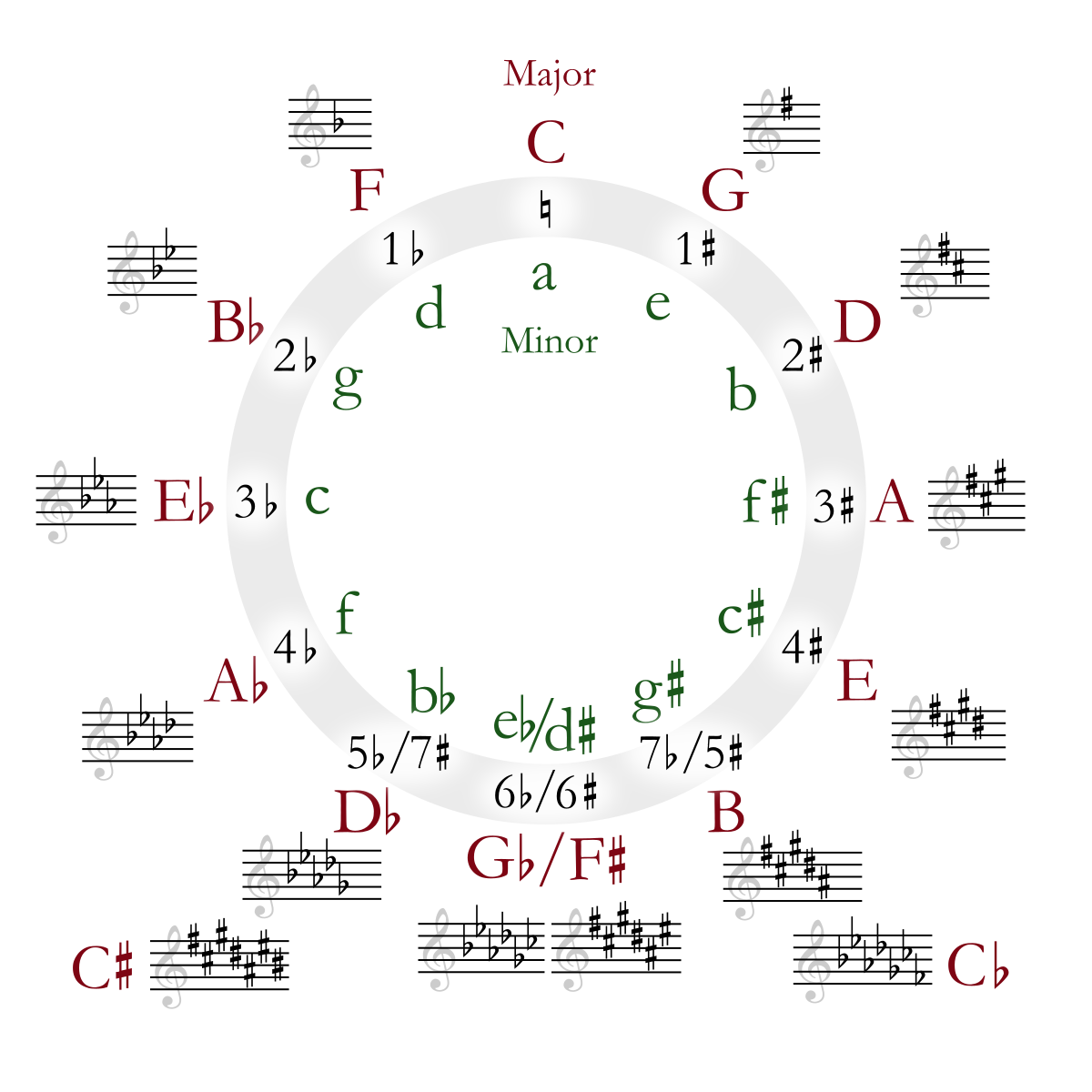Circle of Fifths

Depending on how we are using it, each letter on the circle of fifths can represent:
- individual notes
- chords
- keys
Notice
- If we go clockwise, we are ascending by a 5th interval (or descending by a 4th); if we go counterclockwise, we are ascending by a 4th (or descending by a 5th)
- As we go around the circle clockwise (starting from C), we notice that C has no sharps/flats, G has 1 sharp, D has 2 sharps, A has 3 etc.
- this demonstrates that the closer letters are to each other, the more similar they are.
- Also, D has the same sharps as G (plus one more), and A has the same sharps as D (plus one more)
- mn: the order of sharps as they get added: Father Charles Goes Down And Ends Battle
- can be reversed to derive the order of flats as they get added.
- mn: the order of sharps as they get added: Father Charles Goes Down And Ends Battle
- notice that the order that sharps get added is the same note that is found 2 ticks of the circle backwards from the key we are playing in
- ex. From the key of G, the sharp is F#, which is the same note that is 2 spaces backwards from G.
- we can derive the notes of a major scale by taking a tonic, taking the 5 notes in the clockwise direction, along with 1 note in the counterclockwise direction
- ex. in E major, we take A, B, F#, Db, Ab, Eb
- this works equally well for the minor (inner) part of the circle
- the further away a note is from a tonic, the more dissonant it sounds
- the tritone of any tonic is on the opposite side of the circle
- If we start from a tonic and move counterclockwise to its 4th, we will notice a pattern: 4 1 5 2 6 3 7
- keys that are more related to each other (ie. closer together) have only few accidentals that are different from one another. this is why they are considered related keys: hey have almost all the same notes!
- eg. D and A have 2 sharps and 3 sharps respectively. This means only 1 note is different between them making them quite related.
mn: caroline gets drunk and eats butterflies mn: caroline fondles beads
A quirk of the circle of fifths in minor is that the scale degrees are not always a 5th apart.
- ex. In Am, the VI is F and the ii is B. These are a tritone apart, which is necessary for the roots to remain diatonic to the key.
"Look at the circle of fifths. Notice how the notes that are opposite to each other in the circle are a tritone(three whole tones) apart. C and F# are opposite to each other and they are a tritone apart on the piano. G and Db are a tritone apart and they are opposite each other on the circle and so on.
- a way to better recall this is to remember 4 notes on the circle. C,G,F# and F. C is at the top, F# is at the opposite side of C, G is to the right of C, and F is to the left of C. And then, just remember BEAD. On the right side of the circle, BEAD goes up from F# and goes till G, and to the left BEAD goes down from F and goes down to F#. The only difference is that BEAD on the left is all flat, Bb,Eb,Ab,Db."
"Another point: when you look at the key of C, you actually see a family of chords related to that key, right next to each other which represents the "qualities of C". Thus you have your IV, I and V chords right next to C, but then you also have the chords D, A and E, looking to the right, (which in this case would be the relative minors of F, C and G...Dm is the relative minor of F, Am is the relative minor of C, and Em is the relative minor of G. This creates an instant family of chords moving up the scale of C: C, Dm, Em, F, G, Am (and then Bdim is really redundant to a G chord (in part), so we only concentrate on the three primary major chords and the three relative minors in each scale!"
"Glass Doors Are Easily Broken" for the sharps. "
"One of the most useful aspects of the circle of fifths is to deduce the relative minor. It doesn't always feel immediately obvious, particularly if you are in a complex major key at the time, so just move clockwise by three (G major -> E minor). Similarly if you are in a minor key and want the associated major, go anticlockwise by three (D minor -> F major)."
Backlinks